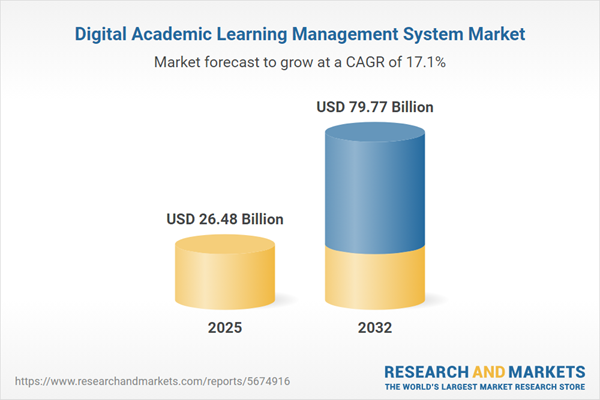Speak directly to the analyst to clarify any post sales queries you may have.
Digital academic learning management systems (LMS) are redefining how organizations and institutions deliver education and workforce training, enabling strategic alignment and transformation at scale. For senior decision-makers, these platforms are crucial for driving consistent learning standards and supporting organizational agility in an increasingly distributed environment.
Market Snapshot: Digital Academic Learning Management System Market
The digital academic learning management system market is expanding rapidly, advancing from USD 22.53 billion in 2024 to USD 26.48 billion in 2025, translating to a compound annual growth rate (CAGR) of 17.11%. This surge is fueled by institutions and corporates embracing LMS technologies to support scalable, flexible learning across diverse operational settings. Innovations in cloud-native infrastructure, streamlined process automation, and improved learning analytics define this growth, enabling robust content management and accelerated digital adoption. Organizations increasingly rely on LMS platforms to boost compliance, enhance engagement, and drive superior learning performance in a competitive marketplace.
Scope & Segmentation: Digital Academic Learning Management System Market
This report offers senior executives comprehensive insight into the evolving LMS marketplace, supporting strategic selection and investment decisions aligned with mission-critical operational needs. The main segments and influencing factors shaping adoption, solution design, and stakeholder value are outlined below:
- Organization Size: Large enterprises use LMS to coordinate learning across departments, optimizing knowledge transfer and compliance at scale; smaller institutions value platforms for streamlined workflows and agile onboarding of staff.
- Component: Core components include consulting, system implementation, enabled partner training, content management solutions, interactive course modules, integrated assessments, and dedicated technical support—each critical for effective deployment and ongoing adoption.
- Deployment Model: Options encompass both cloud-based and on-premises configurations, enabling organizations to meet compliance needs and IT policy requirements whether operating locally or remotely. Flexibility in deployment supports diverse infrastructure landscapes.
- End User: LMS platforms support a wide spectrum, from corporations to government agencies, as well as K–12 schools and higher education institutions. Each group leverages the platforms for tailored compliance management, specialized reporting, and workforce skill development.
- Application: Platforms accommodate functions such as streamlined administrative tasks, blended or hybrid instruction, real-time performance tracking, adaptive assessment, and collaborative learning—driving comprehensive program oversight and continuous workforce advancement.
- Geography: Adoption is strong in regions like the Americas, Europe, Middle East and Africa, and Asia-Pacific. Noteworthy market activity occurs in the United States, Germany, India, and Australia, each characterized by unique regulatory standards and accelerated digital strategy adoption.
- Lead Vendors: Key providers such as Instructure, Blackboard Inc., Moodle Pty Ltd, D2L Corporation, Google LLC, PowerSchool Holdings, Microsoft, Cornerstone OnDemand, Adobe, and SAP SE deliver interoperability for complex educational and organizational needs, supporting seamless integration.
Key Takeaways for Senior Decision-Makers
- LMS platforms allow creation of adaptable, tailored learning paths, supporting both remote and hybrid operational environments for a diverse workforce.
- Cloud-driven and mobile-optimized solutions enable more efficient deployment and continued access for distributed teams or learners, streamlining management and delivery regardless of location.
- Integration with specialized content providers ensures the fulfillment of unique compliance obligations and facilitates organizational resilience in shifting landscapes.
- Systems equipped with inbuilt compliance management and adaptive architectures deliver greater administrative control and a quicker response to regulatory or operational change.
- Automated processes for assessment and certification strengthen visibility into learner progress, supporting feedback loops and continuous improvement for instructors and administrators.
- Alignment with microlearning and evolving digital education standards supports lasting relevance and responsiveness to new learning expectations and workforce requirements.
Tariff Impact on Procurement and Supply Chains
Anticipated changes to U.S. tariffs in 2025 are projected to influence procurement strategies for digital academic LMS solutions. With likely cost fluctuations and evolving processes, organizations are increasingly drawn to cloud-based deployment models to reduce dependence on traditional on-premises infrastructure. In response, institutions are re-evaluating IT environments and potential vendor partnerships to protect compliance and ensure operational continuity during supply chain realignments.
Methodology & Data Sources
This analysis combines quantitative market data with qualitative evidence from peer-reviewed research, government databases, vendor documentation, and direct interviews with industry thought leaders. All insights are rigorously validated to help executives make sound investment decisions regarding digital academic learning management systems.
Why This Report Matters
- Enables executives to make data-driven LMS investment choices that reinforce operational best practices and maintain compliance in dynamic regulatory environments.
- Provides tangible recommendations for leveraging emerging technology to optimize transformation initiatives in alignment with organizational and workforce goals.
- Assists organizations in applying benchmarking methods to effectively navigate policy shifts, evolving skills requirements, and sector-specific learning demands.
Conclusion
Strategic investment in LMS platforms and vendor relationships empowers organizations to lead through regulatory and educational transition. This report provides actionable guidance for digital transformation, supporting sustainable institutional outcomes.
Additional Product Information:
- Purchase of this report includes 1 year online access with quarterly updates.
- This report can be updated on request. Please contact our Customer Experience team using the Ask a Question widget on our website.
Table of Contents
3. Executive Summary
4. Market Overview
7. Cumulative Impact of Artificial Intelligence 2025
Companies Mentioned
The companies profiled in this Digital Academic Learning Management System market report include:- Instructure, Inc.
- Blackboard Inc.
- Moodle Pty Ltd
- D2L Corporation
- Google LLC
- PowerSchool Holdings, Inc.
- Microsoft Corporation
- Cornerstone OnDemand, Inc.
- Adobe Systems Incorporated
- SAP SE
Table Information
| Report Attribute | Details |
|---|---|
| No. of Pages | 188 |
| Published | October 2025 |
| Forecast Period | 2025 - 2032 |
| Estimated Market Value ( USD | $ 26.48 Billion |
| Forecasted Market Value ( USD | $ 79.77 Billion |
| Compound Annual Growth Rate | 17.1% |
| Regions Covered | Global |
| No. of Companies Mentioned | 11 |









